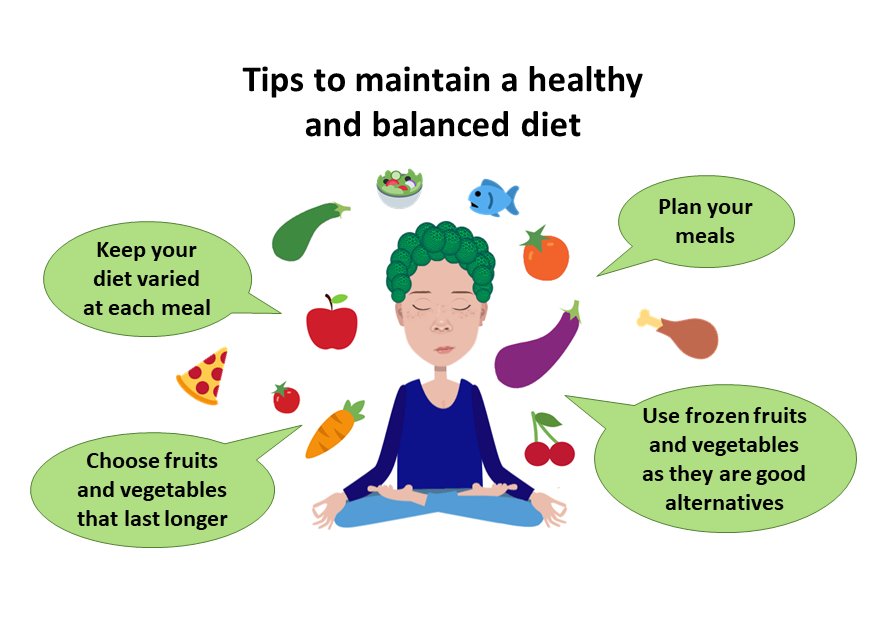Edulia presents: QUALITY FOOD TIME IN QUARANTINE

Staying at home for an extended period of time can be difficult, and healthy eating can be extra challenging due to the more relaxed “weekend atmosphere”. But worry not, because the Edulia team are here to share TIPS on how to make quality food time whilst in quarantine. The tips are presented in the infographics below in different languages (tap/click on the I to see which language), for further details read below.
1) Eat fruits and vegetables to contribute to a healthy and balanced diet

derivative of ©2019 Mirror AI modified by Julia Sick
Try to keep your diet varied at each meal
Try to keep a varied diet and don’t forget to drink an adequate amount of water throughout the day.
It can be difficult to keep up a healthy and balanced diet in these times, but you have a lot done if you focus on fruit and vegetables.
Visit the WHO website to see what a healthy and balanced diet, rich in fruits and vegetables, should look like.
Choose fruits and vegetables that last longer
When it is not possible to frequently go to the supermarket, it may be challenging to eat fresh fruits and vegetables.
- Fruits and vegetables that last longer in the fridge include: apples, carrots, celery, cucumber, cabbage, broccoli, salad, zucchini.
- Fruits and vegetables that can be stored out of the fridge include: beets, squash, tomatoes, potatoes, avocado, bananas, onions, pears, lemons and oranges.

derivative of ©2019 Mirror AI modified by Julia Sick
Frozen fruits and vegetables are good alternatives
Frozen fruits and vegetables have been found to contain similar and sometimes even more nutrients than fresh produce. They are a good choice as they can be stored longer (1,2), and may also be cheaper.
Plan your meals
Planning meals can help you to cut costs and avoid food waste.
The website “Healthy eating on a budget” helps to plan healthy meals that fit your budget.
2)Make healthy snacking attractive
When we are bored at home, it is tempting to mindlessly snack on foods. We may struggle to choose healthy snacks, especially for children who find unhealthy options more appealing. However, encouraging our children to choose healthier snacks may be easier than it looks. Here are some tips to help you:

derivative of ©2019 Mirror AI modified by Julia Sick
Make healthy snacks available and easily accessible
Your child will be more likely to eat healthy snacks if these snacks are easy to reach and to consume (3). Keep healthy snacks in children’s eyesight, like in a fruit basket on the dining table. Also, you can cut healthy snacks in pieces so that it is ready and easy to eat.
Cut healthy snacks into funny shapes
Did you know that children are likely to eat more visually appealing fruit compared to regular fruit (4)? For example, you can cut vegetables in funny shapes. Here can you learn how to do this.
Combine different fruits or vegetables
Serving a variety of fruits or vegetables rather than providing a single fruit or vegetable may increase the intake of your child (5). For example, you can combine different fruits in a bowl so that your child is able to choose from multiple types of fruit and select their preferred ones.

derivative of ©2019 Mirror AI modified by Julia Sick
3)Cook and eat together
Normally, our busy lifestyle can make family meals a challenge. But we can take advantage of the current situation and make time to eat together, and even cook together. Research has shown that more frequent family meals are associated with many benefits for the child, like a decreased risk of obesity (6), a higher intake of healthy food (7), better linguistic and academic performance (7, 8) and improved well-being (9). Involvement in cooking activities can increase children’s food acceptance and improve their diet quality (10-13). Through cooking, knowledge about ingredients is built, fine-motor skills are trained, and the senses are sharpened.

derivative of ©2019 Mirror AI modified by Julia Sick
Model healthy and positive eating behavior at the table
Set a good example. Children are more likely to eat and try foods when they see their parents eat and enjoy the same foods (14).
Keep in mind that family meals are more than eating
- Focus on enjoying each other’s company, not on what or how much each child is eating.
- Encourage children to talk about their day, this helps to develop more communication between family members.
- Turn off distractions like the TV, computer, tablets and phones during mealtimes.
More tips and strategies for family mealtimes are available here (in several languages).
Brainstorm for the meals of the week
The current situation might bring the need to plan your meals in advance. Brainstorm meals of the week together using post its and have a family voting to make meal planning more engaging.

derivative of ©2019 Mirror AI modified by Julia Sick
Do a Creative Cooking session with your family (15)
- Set a theme for the menu to increase the collaborative energy
- Define a Kitchen Captain for each meal
- Create your own names for dishes
- Personalize meals according to the preferences of each family member
- Be curious and explore the reasons and methods for different cooking steps

Tips and image extracted from: Creative CoCooking patterns | Proceedings of the 20th European Conference on Pattern Languages of Programs, 2020
Challenge your children to cook
Being able to prepare a meal can be empowering for children. Depending on age and personality, different approaches might spark their interest. Here is a set of easy and more advanced cooking challenges from the webpage “bettertogether” that gives hands-on tips how to approach family cooking. Older children might enjoy cooking and baking on their own. Webpages with recipes for children21 and cooking blogs by children, Chefgrace, Fabfunfoodclub, thebrilliantchef can provide some inspiration.
4)Play with your food, for young and old
It’s perhaps counter intuitive to what we were taught as children, but recent research has demonstrated that encouraging children to play and interact with food actually increases their willingness to taste. This short TED talk explains why playing with our food encourages children, not solely to learn about what’s on their plate, but also to taste different foods. There are many creative ways to interact with food, but here are just a few suggestions.
Create artistic stamp pictures
For younger children, or children who are very reluctant to try fruits and vegetables, begin with an art activity to get them exploring feared foods in a fun and ‘safe’ way. Use chopped vegetables with different textures to make artistic stamp pictures, as here. What’s better, is that by using the coloring from the beet as the ink, the vegetables won’t go to waste, as they can still be cooked and eaten afterwards.
Create and eat it!
Most children love animals. Why not have a go at creating different animals with the products you have in the fridge, like fruits and vegetables, then eat them together after.24 Involving children in artistic plating of food has been shown to improve mood and that visually appealing food can increase the intake of new foods (16).

Not excited about animals? No problem! Create your own heroes, Disney characters, etc. For more inspiration check out @fun_food_for_my_kids and @foodmakesfun via Instagram.

@fun_food_for_my_kids

Michelle Lim@foodmakesfun, accessed 27 March 2020
BINGO!
Studies have shown that playing games with real fruits and vegetables increases children’s willingness to try (17). Create a bingo card of foods you have in the house and then prepare them in a variety of ways and ask the child to figure out what the food is and whether they have it on their bingo card. This also helps increase a child’s understanding of how food can vary in appearance, so they become more familiar with different modes of food presentation. Food bingo examples can be found at Nourish Interactive.
Sense your food!
Involving children in sensory games can increase children’s acceptance of food – especially if it is unfamiliar to them (18-21) All our 5 senses (sight, smell, taste, touch and hearing) play an important role when we taste food. Explore some of them in playful activities that you can easily do at home! The “Smell Detection Game” and “The Flavor vs Taste Experiment” are novel methods of sensory play.

derivative of ©2019 Mirror AI modified by Julia Sick
Be a magician!
Last but not least, impress children with food experiments and magic tricks such as this banana trick.

derivative of ©2019 Mirror AI modified by Julia Sick
5)Learn about your food
Learning about nutrition and other aspects of food is an important part of education. Here are different tips on how to educate children about food from home:
Explore online tools
- Teach young children about foods and a varied diet with fun online materials, such as this video.
- “Vegetable Maths Masters” offers interactive games that combine math and healthy eating.
- Also, we highly recommend the App that Tija Rageliene (ESR7) has developed within her research. In the App “Food Boss” children can explore how a healthy and balanced dish is composed and interact with peers.

derivative of ©2019 Mirror AI modified by Julia Sick
Grow fruits and vegetables
Spring is here, so this is a good time to plant some seeds and observe them grow. Research has shown that the involvement of children in growing their own vegetables and fruits improved their consumption for these food groups (21).
- Do a natural science experiment on how soil type influences the seed germination
- Or simply plant some vegetables inside, on the balcony or in the garden.

derivative of ©2019 Mirror AI modified by Julia Sick
The images displaying the Edulia figure are a derivative of ©2019 Mirror AI modified by Julia Sick.
Scientific background on our tips
- Marques, K. K., Renfroe, M. H., B. Brevard, P. B., Lee, R. E., & Gloeckner, J. W. (2010). Differences in antioxidant levels of fresh, frozen and freeze-dried strawberries and strawberry jam. International journal of food sciences and nutrition, 61(8), 759-769.
- Mullen, W., Stewart, A. J., Lean, M. E., Gardner, P., Duthie, G. G., & Crozier, A. (2002). Effect of freezing and storage on the phenolics, ellagitannins, flavonoids, and antioxidant capacity of red raspberries. Journal of Agricultural and Food Chemistry, 50(18), 5197-5201.
- Ong, J. X., Ullah, S., Magarey, A., Miller, J., & Leslie, E. (2017). Relationship between the home environment and fruit and vegetable consumption in children aged 6–12 years: A systematic review. Public Health Nutrition, 20(3), 464-480.
- Lycett, K., Miller, A., Knox, A., Dunn, S., Kerr, J. A., Sung, V., & Wake, M. (2017). ‘Nudge’ interventions for improving children’s dietary behaviors in the home: A systematic review. Obesity Medicine, 7, 21-33.
- Roe, L. S., Meengs, J. S., Birch, L. L., & Rolls, B. J. (2013). Serving a variety of vegetables and fruit as a snack increased intake in preschool children. The American journal of clinical nutrition, 98(3), 693-699.
- Berge, J. M., Wall, M., Hsueh, T. F., Fulkerson, J. A., Larson, N., & Neumark-Sztainer, D. (2015). The protective role of family meals for youth obesity: 10-year longitudinal associations. The Journal of pediatrics, 166(2), 296-301.
- Snow, C. E., & Beals, D. E. (2006). Mealtime talk that supports literacy development. New directions for child and adolescent development, 2006(111), 51-66.
- Cullen, K. W., & Baranowski, T. (2000). Influence of family dinner on food intake of 4th to 6th grade students. J Am Diet Assoc, 100(suppl), A38.
- Musick, K., & Meier, A. (2012). Assessing causality and persistence in associations between family dinners and adolescent well‐being. Journal of Marriage and Family, 74(3), 476-493.
- Allirot, X., da Quinta, N., Chokupermal, K., & Urdaneta, E. (2016). Involving children in cooking activities: A potential strategy for directing food choices toward novel foods containing vegetables. Appetite, 103, 275-285.
- Cunningham-Sabo, L., & Lohse, B. (2013). Cooking with Kids positively affects fourth graders’ vegetable preferences and attitudes and self-efficacy for food and cooking. Childhood Obesity, 9(6), 549-556.
- Jarpe-Ratner, E., Folkens,S., Sharma, S., Daro,D., Edens, N.K. (2016). An Experiential Cooking and Nutrition Education Program Increases Cooking Self-Efficacy and Vegetable Consumption in Children in Grades 3–8, Journal of Nutrition Education and Behavior,Volume 48, Issue 10, 697-705.
- Nelson, S., Corbin, M. and Nickols-Richardson, S., (2020). A Call For Culinary Skills Education In Childhood Obesity-Prevention Interventions: Current Status And Peer Influences. Journal of the Academy of Nutrition and Dietetics, Volume 113, Issue 8, 1031-1036.
- Addessi, E., Galloway, A. T., Visalberghi, E., & Birch, L. L. (2005). Specific social influences on the acceptance of novel foods in 2–5-year-old children. Appetite, 45(3), 264-271.
- Isaku, T., & Iba, T. (2015). Creative CoCooking patterns: a pattern language for creative collaborative cooking. EuroPLoP ’15.
- Maiz E, Urkia I, Bereciartu A, Urdaneta E, Allirot X. Introducing novel fruits and vegetables: Effects of involving children in artistic plating of food. Food Qual Prefer. 2019;77:172-183. doi:10.1016/j.foodqual.2019.05.006
- [Coulthard, H. and Ahmed, S., 2017. Non taste exposure techniques to increase fruit and vegetable acceptance in children: Effects of task and stimulus type. Food Quality and Preference, 61, pp.50-54
- Coulthard H, Williamson I, Palfreyman Z, Lyttle S. Evaluation of a pilot sensory play intervention to increase fruit acceptance in preschool children. Appetite. 2018;120:609-615. doi:10.1016/j.appet.2017.10.011
- Nekitsing C, Blundell-Birtill P, Cockroft JE, Fildes A, Hetherington MM. Increasing Intake of an Unfamiliar Vegetable in Preschool Children Through Learning Using Storybooks and Sensory Play: A Cluster Randomized Trial. J Acad Nutr Diet. 2019;119(12):2014-2027. doi:10.1016/j.jand.2019.05.017
- Coulthard H, Sealy A. Play with your food! Sensory play is associated with tasting of fruits and vegetables in preschool children. Appetite. 2017;113:84-90. https://www.sciencedirect.com/science/article/pii/S019566631730185X?via%3Dihub.
- Langellotto, G. and Gupta, A., 2020. Gardening Increases Vegetable Consumption In School-Aged Children: A Meta-Analytical Synthesis.











